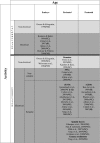Early NMDA receptor-driven waves of activity in the developing neocortex: physiological or pathological network oscillations?
- PMID: 19917570
- PMCID: PMC2821549
- DOI: 10.1113/jphysiol.2009.178798
Early NMDA receptor-driven waves of activity in the developing neocortex: physiological or pathological network oscillations?
Abstract
Several patterns of coherent activity have been described in developing cortical structures, thus providing a general framework for network maturation. A detailed timely description of network patterns at circuit and cell levels is essential for the understanding of pathogenic processes occurring during brain development. Disturbances in the expression timetable of this pattern sequence are very likely to affect network maturation. This review focuses on the maturation of coherent activity patterns in developing neocortical structures. It emphasizes the intrinsic and synaptic cellular properties that are unique to the immature neocortex and, in particular, the critical role played by extracellular glutamate in controlling network excitability and triggering synchronous network waves of activity.
Figures




References
-
- Adelsberger H, Garaschuk O, Konnerth A. Cortical calcium waves in resting newborn mice. Nat Neurosci. 2005;8:988–990. - PubMed
-
- Arumugam H, Liu X, Colombo PJ, Corriveau RA, Belousov AB. NMDA receptors regulate developmental gap junction uncoupling via CREB signalling. Nat Neurosci. 2005;8:1720–1726. - PubMed
Publication types
MeSH terms
Substances
LinkOut - more resources
Full Text Sources
Medical

